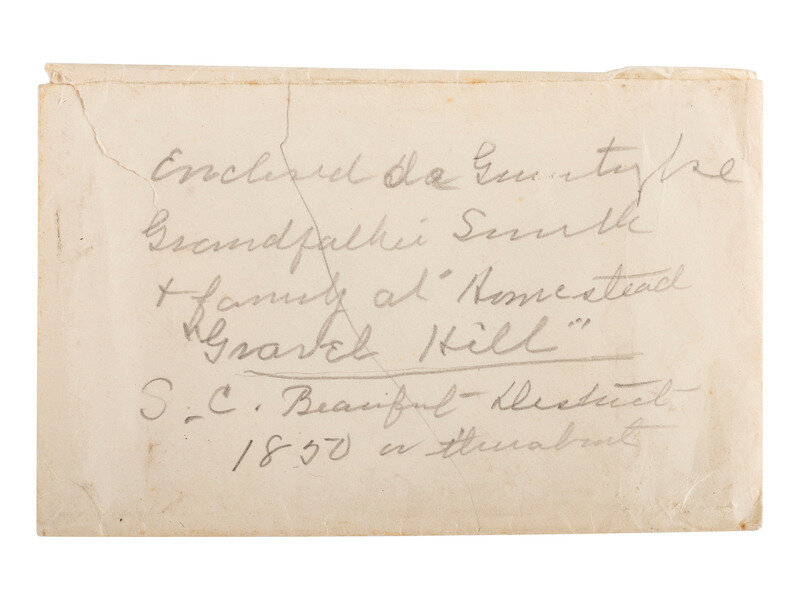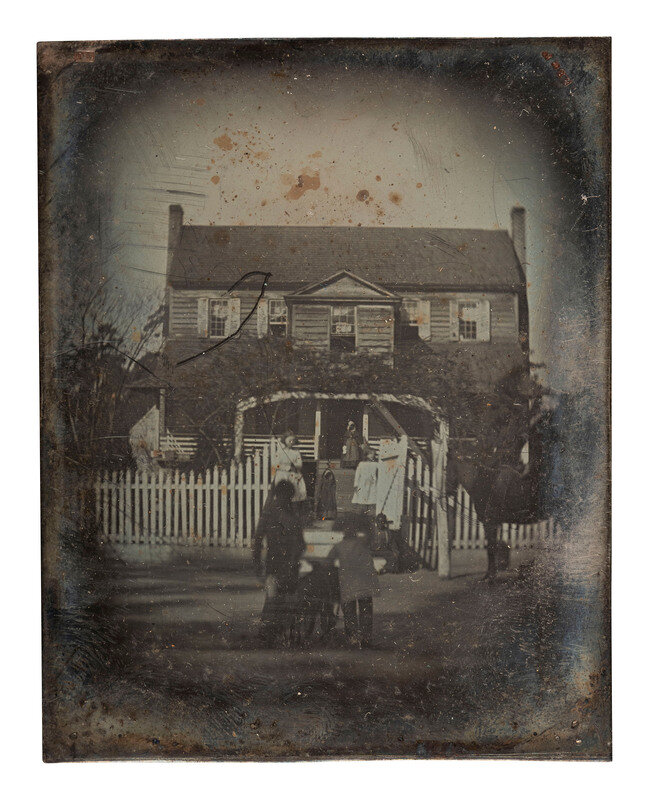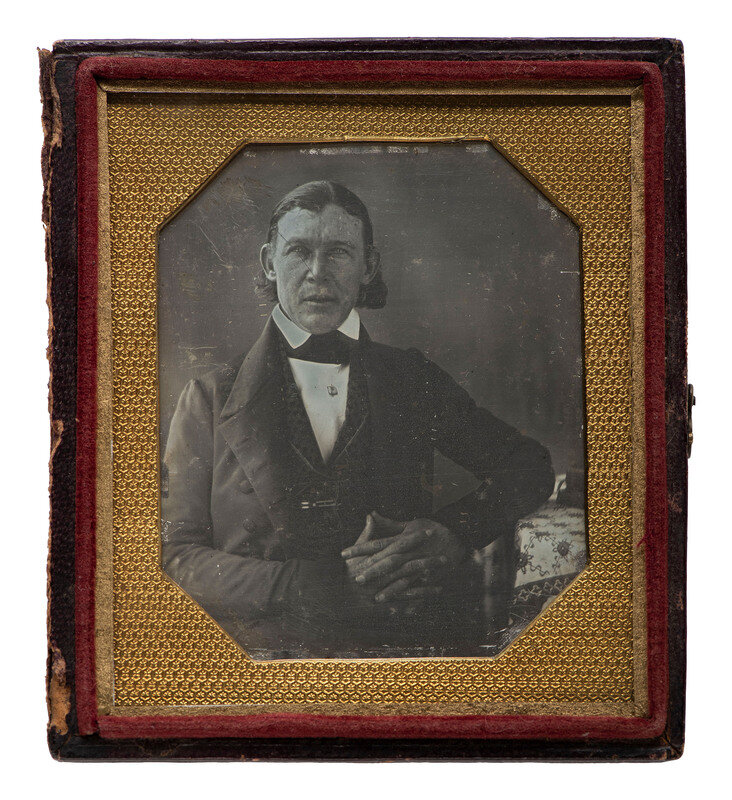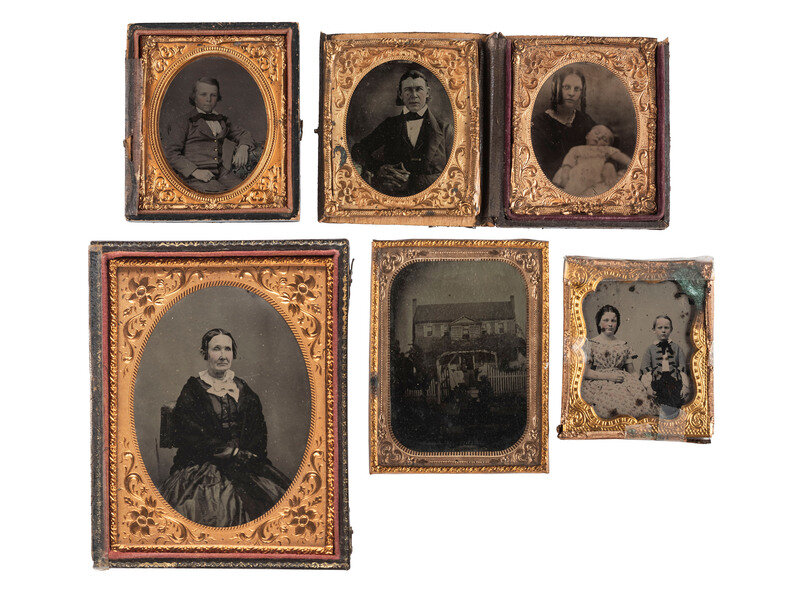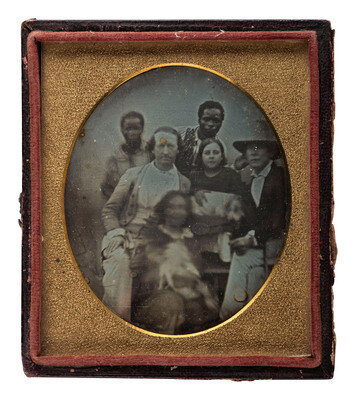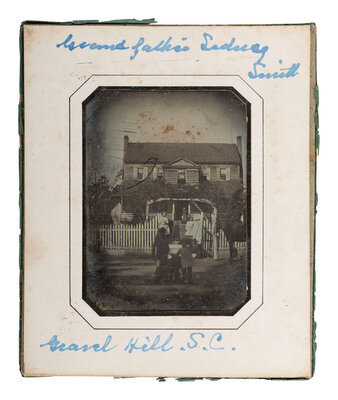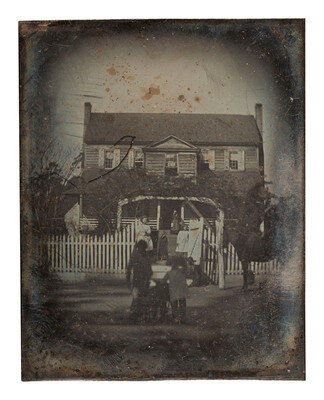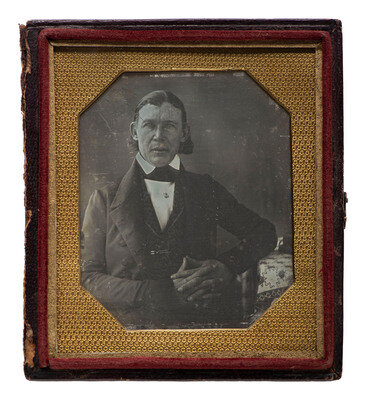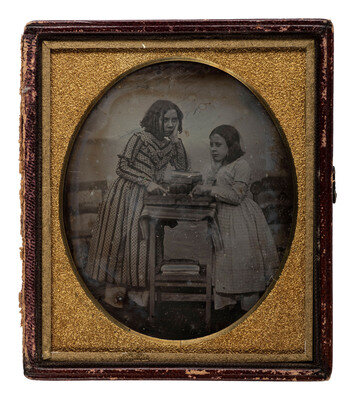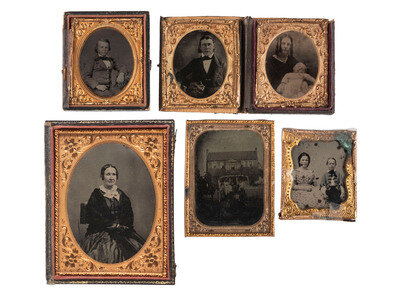Condition Report
Contact Information
Auction Specialist
Lot 429
[EARLY PHOTOGRAPHY]. A collection of images associated with South Carolina doctor and plantation owner Sidney Smith, including what may be the earliest known images of an identified plantation and enslaved African Americans posed with their owner.
Sale 2057 - American Historical Ephemera and Photography
Oct 25, 2024
10:00AM ET
Live / Cincinnati
Own a similar item?
Estimate
$20,000 -
30,000
Price Realized
$16,510
Sold prices are inclusive of Buyer’s Premium
Lot Description
[EARLY PHOTOGRAPHY]. A collection of images associated with South Carolina doctor and plantation owner Sidney Smith, including what may be the earliest known images of an identified plantation and enslaved African Americans posed with their owner.
The collection is comprised of the following images:
Oversize quarter plate daguerreotype (4 x 3 1/8 in.) in passe-partout mat of Gravel Hill Plantation, near Robertville, St. Peter’s Parish, Beaufort District, SC Ca mid-to-late 1840s. With inked notation on mat, “Grandfather Sidney Smith, Gravel Hill S.C.” The image shows various figures engaged in an unknown activity, with a horse tied to a picket fence. The two girls in white may be Sidney Smith’s daughters Arabella and Julia, and the others may be enslaved African American children. An enslaved African American subject stands on the steps in the background. A grape arbor is also evident, notable because Dr. Smith experimented in viniculture. In the foreground are two figures with an unknown object, perhaps a dog cart, or a bone-shaker bicycle. A quarter plate tintype copy of this scene is also included.
Sixth plate daguerreotype of Sidney Smith, his brother James Laurens Smith, daughters Arabella and Julia Smith, with two unidentified African American men, almost certainly enslaved subjects. Ca mid-1840s-1850. One of the girls is blurred because she is holding a dog. Accompanied by the envelope in which the daguerreotype was discovered, with penciled notation about the subjects as well as a tentative date of "1850 or thereabout."
Sixth plate daguerreotype of two girls, Arabella and Julia Smith, pointing to a book and an unidentified object. Ca mid-1840s-1850.
Sixth plate daguerreotype of Sidney Smith, possibly a self-portrait. Ca 1845. Smith appears to be wearing a mourning band on his coat, which suggests that the image was made in 1845, after his first wife died in March of that year. A sixth plate tintype copy of this portrait is also included.
Additional images of family members include: Sixth plate tintype portrait of Maria King Smith, second wife of Sidney Smith, with an infant, possibly William King Smith. A period copy image. Ca 1850s. – Sixth plate ambrotype of William King Smith, son to Sidney and Maria Smith, possibly as a cadet. Ca 1850s. – Quarter plate ambrotype of Sarah Smith, sister of Sidney and James Laurens Smith. Ca 1850s-1860s. – Sixth plate ambrotype of Rosa Nicholes, sister of Mariah Smith, with “Eddie” Postell, possibly killed in action at Fort Wagner. Ca 1850s.
Sidney Smith was born in 1805 in or near Beaufort, SC (dates vary), the son of William Smith, a man of moderate wealth, and Elizabeth Wilson Smith of Philadelphia, reportedly of Quaker faith (Geoffrey 1982). William evidently encouraged his sons Sidney and James Laurens Smith (b. 1809) to pursue professional careers in medicine and law, thus Sidney was sent to Yale College (later University) and subsequently studied medicine (location unknown, possibly Ohio). Although James studied law, he apparently never practiced, preferring to study agriculture, and experimenting with crops and farming methods (Geoffrey 1982; and Dexter 1913: 116).
Sidney Smith married Eliza Lawton in 1829, and was apparently practicing medicine in the Robertville, SC, area, as well as trying his hand at being a planter. In 1831, he turns up in the Lawton Family Papers as having been paid two dollars for “…expirating a Fungus Tumor from the head of Little Negro Shiloh” (Inabinett 1963). Thence forward, he was engaged in several land transactions in the upper St. Peter’s Parish in Beaufort District. He seems to have been interested in experimenting with crops in this region. The following advertisement, in the Boston Daily Atlas of 28 December 1844, first appeared in the Savannah Republican:
“This editor of the Savannah Republican has samples of eight kinds of wine, made by Dr. Sidney Smith, of Robertville, Beaufort District, SC They are pure juice of the grape, without the addition of any spirits whatever. One of the specimens is from the vintage of 1833, another from that of ’38, and the other six from that of the present year. They differ in flavor, according to the species of grape from which they were expressed…Dr. S. has on hand some 800 gallons of those wines, which he finds useful for all medicinal and culinary purposes” (Ruthrawls.wordpress.com).
Smith owned a plantation called Gravel Hill in South Carolina (Geoffrey 1982), but the question has been raised as to Gravel Hill’s exact location. This question becomes more complicated considering the numerous plantation homes, grand and humble alike, that dotted the Beaufort District in the antebellum years, as well as the number that succumbed to the torch at the close of the Civil War in 1865. Two possibilities suggest themselves: 1. The large plantation house known as Gravel Hill near Allendale, SC (see National Register of Historic Places, Gravel Hill, Allendale, SC). There are several issues with this location, including the fact that it was purportedly built in 1857-1858 by Benjamin Lawton Willingham; 2. A ca 1910 hunting plantation near Robertville, also placed on the National Register. Genealogical records at the Heritage Library Foundation note that Sidney Smith sold his plantation properties in the Robertville vicinity, including Gravel Hill, to John Goldwire Lawton in 1853. According to the application for this property found at the National Register of Historic Places, it was purchased by John Goldwire Lawton in 1853, and the elaborately decorated center-hall plan home was burned by W.T. Sherman’s troops in 1865 (along with the town of Robertville). Newer structures were apparently built on the foundations of the original Gravel Hill around 1910 when it was refashioned as a gentleman’s hunting plantation. Research indicates that this is likely the original location of the “Gravel Hill” structure featured in the daguerreotype offered here.
Although the daguerreotypes included in the collection are uncredited, further details involving Smith’s personal interests suggest that he may have taken some of the images, most importantly the Gravel Hill daguerreotype and the group portrait of Smith, his brother, and two daughters informally posed with two unidentified Black men. The published biographical obituaries of Yale graduates reveal the following about Smith:
“He [Sidney Smith] was a man of unusual mental gifts, an earnest student and devoted to the community and mankind. When the art of the daguerreotype was first introduced, he was a pioneer in cultivating it in the South.” Interestingly, the biography also notes that Smith “opposed strenuously the act of nullification in South Carolina, and by his personal actions retarded the action of the state.” This may have well placed Smith at odds with many of his neighbors in the Antebellum South.
Based on his interest in the “art of the daguerreotype,” it is possible that Smith created the daguerreotypes himself, perhaps with the aid of an assistant so he could be included in certain images, most notably the group portrait. The subjects of this image as well as those captured in the Gravel Hill daguerreotype seem more relaxed. As such, these images appear more intimate, as if they are Daguerreian snapshots of the family rather than formally arranged portraits.
The approximate dating of the featured images has been determined based on the estimated ages of Smith’s daughters, Arabella and Julia, who are pictured in two of the daguerreotypes. Arabella (b. 1832) and Julia (b. 1837) appear to be around the ages of twelve/thirteen and eight/nine respectively. This would date the daguerreotypes to the mid-1840s and no later than 1850, thus making them among the very earliest photographs of a slave-holding antebellum plantation.
By 1850, Smith and most of his family had relocated to Marietta, Georgia, where he acquired another plantation near Marietta, called Rockford. By 1850, Smith had acquired 74 slaves according to the 1850 Slave Schedules of the US Census.
Smith’s first wife, Eliza, died in 1845, at the age of 37, possibly explaining her absence from the group image. In 1846, Smith got married for a second time to Maria Ann King, with whom he had two children that survived into adulthood, including William King Smith (b. 1846) and Walter Watson Smith (b. 1849) (dates obtained from Find-a-Grave).
In 1853, Sidney Smith sold Gravel Hill, then being a property of 700 acres, and two other plantations, including Horse Pond and one of about 1,050 acres (Heritage Library Foundation). Upon the deaths of Smith and his second wife in 1856, their two sons became wards of Smith’s brother James, who himself apparently died in 1865 (no burial place has been located). Walter Smith was a student at the Georgia Military Institute when it closed at the time of W.T. Sherman’s approach in 1864. At the age of 14, Walter and the other cadets were sent to guard the river crossings in the approaches to Atlanta. With his brother William, Walter served in Confederate units until the end of the Civil War. Sidney Smith’s sister Sarah, known as “Aunt Sarah” to Walter and William Smith, penned some vivid letters describing the evacuation of Marietta and her flight to Atlanta (Geoffrey 1982).
While no documented evidence of the Smith family’s opinions on slavery has been found, Susan E. Geoffrey suggests in her academic paper, “A Southern Family in Transition, 1830-1865,” that Sidney and his siblings were “reasonably humane to their slaves according to the standards of their society.” Furthermore, Geoffrey notes that Sidney’s sisters Sarah and Hannah developed an interest in educating their brothers’ enslaved children.
Although the circumstances under which the images were taken remain unknown, it is evident that Sidney Smith wanted to create a visual record of his plantation home at Gravel Hill as well as his family and the enslaved individuals that worked for him. The daguerreotypes offered here, most notably the group portrait of Smith with his brother, daughters, and two Black men, are unique in depicting enslaved subjects posed together with their owner, especially in a relatively informal setting. To date, no comparable images dating from the mid-to-late 1840s have been located.
An exceptional collection of photographs from an identified family in the Antebellum South, worthy of further research.
References Cited
Dexter, Franklin Bowditch
1913 Biographical Notices of Yale College Graduates 1816-1884, Supplement to Obituary Notices.
New Haven, CT
Geoffrey, Susan E.
1982 “A Southern Family in Transition, 1830-1865.”
Accessed online through the Heritage Library History and Research Center in Hilton Head, SC, September-October 2024. Background on the Smith family is derived from this academic paper, although the research center’s copy is incomplete, lacking numerous footnotes and bibliography. Some, but not all, of Geoffrey’s sources have been located in the William King Smith Papers, Wilson Special Collections Library, UNC Chapel Hill.
Inabinett, E.L.
8 June 1963 “The Lawton Family of Robertville, SC.” Paper delivered to the Lawton Family Reunion. Heritage Library Foundation.
National Register of Historic Places
Accessed online September-October 2024
Ruthrawls.wordpress.com.
Accessed online September-October 2024.

